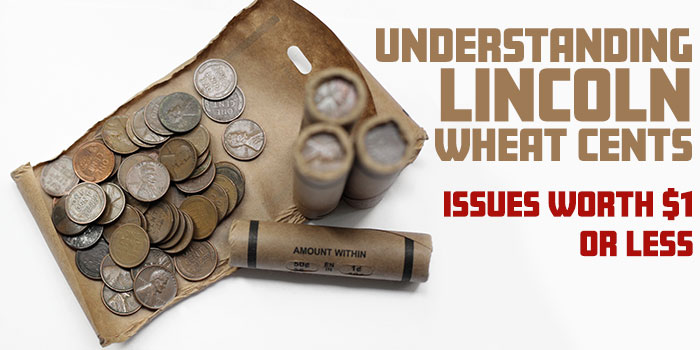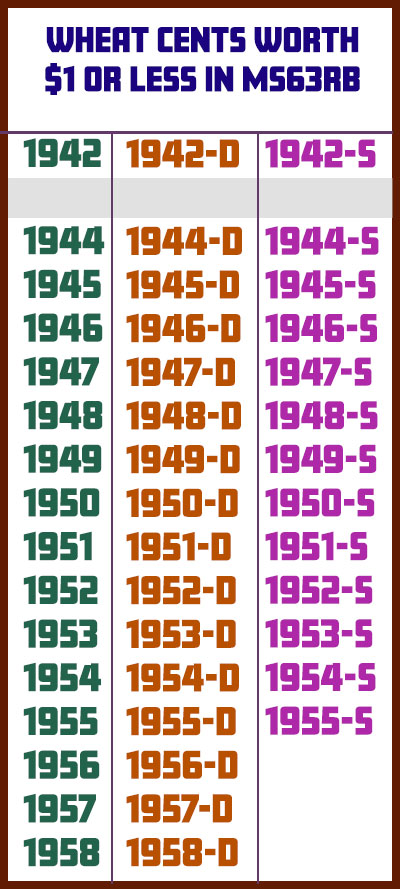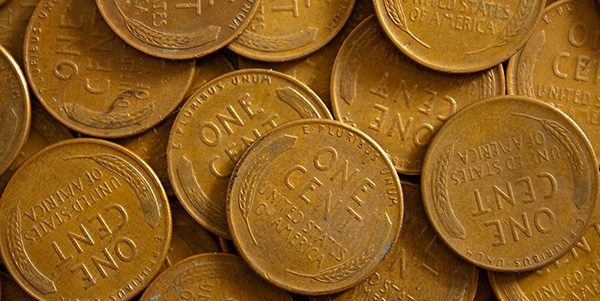
By Chris Bulfinch for CoinWeek …..
Lincoln Wheat cents turn up in pocket change, the effects of loved ones, and in rolls of cents tucked away in drawers.
Struck by the unfamiliar reverse design and age, many who come across these coins start Googling, only to find a deluge of jargon-laden auction listings, price estimates, and news stories about “million-dollar pennies” that leave them more confused about the value of their coins than when they started. Often, coin dealers have to deflate people’s hopes for quick riches.
The disconnect between the headlines and reality can be jarring. In this short series of articles, we’ll try to demystify the Wheat cent by explaining several different price tiers into which most Wheat cents fall. We’ll start with cents struck between 1942 and 1958, the series’ end, that grade Mint State 63 Red and Brown (MS-63RD). All of these dates can be purchased for $1 or less.
Two major factors contribute to the virtually nonexistent market value for low-to-mid-grade uncirculated cents struck from 1942 to 1958: large mintages and high survival rates.
According to David Lange, author of The Complete Guide to Lincoln Cents, mintage totals began rising in 1940, and cent production passed the one billion mark for the first time in 1944 (though that level wouldn’t be reached again until 1956). Mintages for the last leg of the series were larger than for earlier dates, making all entries in the date range abundant and affordable. In MS-63RB, most of the dates struck between 1942 and 1958 are available to collectors for less than a dollar. Attractive as these cents can be in low-to-mid-uncirculated grades, they lack any market value.
Shortly after production began ramping up in the early 1940s, wartime exigencies changed the cent’s composition. Tin was almost entirely removed in 1942, though its absence made little difference to the coins’ appearance. A more dramatic change came the next year.
 With copper on the War Production Board’s (the WPB was created by executive order in January 1942 and given broad authority to “exercise general direction over the war procurement and production program”) list of critical war materials, the United States Mint introduced zinc-plated steel cents in 1943. These distinctive coins belong in a higher price tier, as they are worth $4-$8 in MS-63.
With copper on the War Production Board’s (the WPB was created by executive order in January 1942 and given broad authority to “exercise general direction over the war procurement and production program”) list of critical war materials, the United States Mint introduced zinc-plated steel cents in 1943. These distinctive coins belong in a higher price tier, as they are worth $4-$8 in MS-63.
The steel cents proved unpopular with the public, but the WPB was still keen to save copper. An alternative source of the metal was found. Brass shell cases, mainly from .50-caliber rounds, were taken from domestic training facilities and melted down by private contractors, and cents were struck from the resulting copper, with trace amounts of tin, from 1944 to 1946. Though a new alloy was introduced in 1947, according to Roger Burdette’s United States Pattern and Experimental Pieces of WW-II, the recycling of copper from shell cases continued into the late ’40s and possibly beyond.
With the exception of 1943’s steel cents, all of the wartime cents can be purchased for around a dollar in MS-63RB.
In the aftermath of the war, cent production soared but quality declined. The Mint implemented what David Lange describes as “an aggressive cost-cutting program” after the war, which kept worn or chipped dies in use, resulting in poorly-struck coins. The quality of San Francisco Mint coinage declined in this period as well, as the facility began to show its age and the Mint slated its coinage operations for suspension. But despite the worsening quality, uncirculated wheat cents of the 1950s remain abundant.
Though the wartime record of 1.4 billion wouldn’t be surpassed until 1956, mintages remained in the hundreds of millions consistently until the retirement of the wheat ear reverse after 1958.

The San Francisco Mint suspended coining operations in March of 1955, becoming an assay office. The 1955-S Lincoln cent is the last of its type bearing the facility’s “S” mintmark. “S” mint marks reappeared on the cent in 1968 (though striking of cents without mintmarks had resumed in San Francisco in 1965), by which time Victor David Brenner’s wheat ears had been replaced by Frank Gasparro’s Lincoln Memorial.
Large mintages are not the only reason for the ubiquity of uncirculated Wheat cents struck in the 1940s and ’50s. Many of the uncirculated examples in the market were saved in rolls. Roll speculation ensured large populations of the coins exist today in Mint State. Many dealers in the late ’50s and early ’60s sold Mint State rolls of contemporary coins to clients and speculators, a practice common in the United States since the mid-1930s. Sales of Mint State rolls guaranteed the existence of large populations of uncirculated Wheat cents from the ’40s and ’50s, depressing coin values for decades after the roll boom.
As Lange puts it, “Those hoards still hang over the hobby.”
The abundance of Mint State examples allows interested collectors to acquire nice-looking coins inexpensively, but most Wheat cents that non-collectors are likely to come across are not very valuable.
A number of major varieties were struck in the 1942-58 period, and many command significant premiums, but non-collectors would have a hard time attributing them. Experienced dealers and Wheat cent specialists could help, and third-party grading services attribute some varieties. Though some varieties are valuable, many aren’t, and the odds of plucking a rare or sought-after variety from a change dish are fairly low.
Certified examples of Mint State cents struck between 1942 and 1958 are abundant; those in MS-63RB, less so. Most dates in this period have a dozen or more examples certified MS-63RB, but more than a thousand in higher Mint State grades. Lange says that bulk third-party grading created large certified populations of low-to-mid-Mint State coins, while collectors tend to seek out coins graded MS-66 and above. As Lange explains, “coins that fail to make such grades exist in too great a number to have much value.”
Charmy Harker, a California-based Indian Head and Lincoln cent dealer known as “The Penny Lady”, shared in an email interview that she: “[does] carry certified high-grade Lincoln cents in the 1940s – ’50s. However, the raw, lower-end Lincolns in that time period are not that profitable and not cost-effective for me to catalog, process, and bring them to shows. But there are a lot of dealers who do have a large quantity of raw later date wheat cents in lower grades.”

Collectors should not have too much trouble finding examples that would grade MS-63RB, whether in a TPG slab or not. It’s a buyer’s market for later-date Lincoln cents in lower uncirculated grades.
Nevertheless, low market value does not make the coin worthless. The Wheat cent was a long-lived and storied series that has engaged many hobbyists and non-hobbyists alike since its introduction in 1909. Later-date Lincoln cents in low-to-mid-uncirculated grades are worthy collectibles despite their negligible retail value. Shell case brass cents and the last Wheat cents from the San Francisco Mint represent fascinating chapters in the denomination’s history (as well as that of the U.S. Mint) and can be bought for a dollar or two at almost any coin shop or show.
This ubiquity is a double-edged sword, however, and sellers need to realize that large mintages and high survival rates created huge populations of the coins for which demand is limited.
* * *
Sources
Burdette, Roger W. United States Pattern and Experimental Pieces of WW-II. Great Falls, VA: Seneco-Mill Press, 2012.
Harker, Charmy. Letter to Christopher R Harker. April 7, 2021.
Lange, David W. Letter to Christopher R. Bulfinch. April 8, 2021.
–. The Complete Guide to Lincoln Cents. Irvine, CA: Zyrus Press, 2005.
Silber, William L. The Story of Silver: How the White Metal Shaped America and the Modern World. Princeton: Princeton University Press, 2019.





I. Have a 1941 brass or gold wheat penny it weighs 3 1/2grams anorml penny weighs 2.4. Grams how do I find out about this penny
It actually weighs 3.1
1909-1982 wheat/memorial pennies weigh 3.11 grams, except zinc coated steel pennies that weigh 2.70 grams. 1982- date weigh 2.5 grams. 1941 cents were copper… 95%, 5% tin/zinc… but still 3.11 grams.
So how much does a 1943 copper weight?
So do u still have the 1943 coin?
I have a 1909 wheat Penny no mint mark. I have a lot of rare wheat penny’s.
Is there a book or email you could send me once a week or something
Enjoyed your write up, would like see more.
I have a 1932 wheat penny i have no clue what to do how can i see if its worth anything???
I have a 1906 Joe about that one?
I have a penny that looks silver, I wasn’t sure if it was worth anything or not. So I put in inside a drawer in my laundry room for safe keeping. But when I took it out a few weeks back, I noticed that a laundry pod had leaked out a little bit on it, and it looks like it may have messed it up some. How can I find out or where do I have to look at her a website or whatever to see if this penny is even worth any money?
Run a magnetic over it if it sticks and it’s a 1943 its not worth much if it a 1944 and it sticks then I’d ask to Barrow 100,000 cause it worth alot
Why is that?
I have an 1898 indian penny also a 1919 1912 and 1920 wheat pennies and many others all came from my girlfriend she work in retail so she would find them and bring them to me also have a 1957 silver certificate dollar
I have a 1921 wheat penny good shape n a 1898 n 1921 silver dollar excellent shape
I have a 1935 plain wheat penny. No mint
I have a 1929 wheat penny without a mint stamp, is it worth anything?
I have 1941 and 1944 wheat pennies each with no mint mark. How can I find the values?
I have silver wheat penny from 1943.s 1944 1945.1919 some silver an so copper who or how can i see wha they are worth
Well I’m change up I was wondering are 192 no mint ,192 no mint looks 2 but shade d mint are the collectables also 195 ghost looks to be 5 filled mint any thought
People asking the value of their wheat pennies… Google it. You can find pricing and sale data on all of this stuff.
I have a nice 1930 NMM HOW DO YOU TELL IF IT’S VALUE
I have a 1922 penny with no mint mark on it . is it worth anything
I have a 1943 steel penny.
I have a 1945, a 1959, and a few 1969 pennies , are they worth anything
Hello how you doing I have a 1944 penny in a 1983 in a 1956 penny how much is it worth
I have a 1969 D with floating roof and it doesnt have FG initials on the back…and it also doesnt have linclon on his chair like all the others.. I was wondering if it is worth alot of money?? I tried to look it up but know one has anything like it?
Have a few buffalo pennies and a 1940 no mint mark what are they worth?
I have 1909 .1918s .1920s 1922s.1934s.1943sstill and bronze .e1956s .1972s.1968s and many more old penny like this tell me where is can sell.
I have a1918,1919, 1922, 1926, 1927, 1936,1937,1941,1944,1948,1950 wheat cents anybody know if they are worth anything or not. I believe I have more I just haven’t gotten to them yet.
I have a 1944 and a 1952 with a D under the date can anyone tell me if they are worth anything. I tried to look it up but some places say 1.00$ and some say as much as 20,000 , if anyone could help it would be greatly appreciated thank you
Thank you for your Article! I have several different date Wheat Pennies and looking them up on Internet for value has been confusing so your article really helped.
Me too. I have all them in everyway
I have a 1913 penny. Any worth with this one